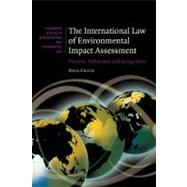
Note: Supplemental materials are not guaranteed with Rental or Used book purchases.
Purchase Benefits
Looking to rent a book? Rent The International Law of Environmental Impact Assessment: Process, Substance and Integration [ISBN: 9780521879453] for the semester, quarter, and short term or search our site for other textbooks by Neil Craik. Renting a textbook can save you up to 90% from the cost of buying.
| Acknowledgments | p. xi |
| Table of cases | p. xiii |
| Table of international instruments | p. xvi |
| Introduction | |
| Introduction and overview | p. 3 |
| EIAs and the process and substance of international law | p. 3 |
| Proceduralism, transnationalism and integration | p. 6 |
| EIAs and compliance | p. 11 |
| Overview | p. 14 |
| Method | p. 16 |
| Background norms | |
| Domestic origins of international EIA commitments | p. 23 |
| Introduction | p. 23 |
| Elements of domestic EIA processes | p. 25 |
| Domestic EIA structure: process and substance | p. 34 |
| The roles of domestic EIA processes | p. 37 |
| EIA in developing countries | p. 42 |
| Application of domestic EIA beyond the state | p. 45 |
| Conclusion | p. 51 |
| EIAs and general principles of international environmental law | p. 54 |
| Introduction | p. 54 |
| Nondiscrimination | p. 55 |
| The harm principle | p. 59 |
| The duty to cooperate | p. 68 |
| The proceduralization of the harm principle | p. 72 |
| Sustainable development | p. 77 |
| Conclusion | p. 82 |
| EIA commitments in international law | |
| Sources of international EIA commitments | p. 87 |
| Introduction | p. 87 |
| Explicit EIA commitments | p. 90 |
| Formally non-binding instruments | p. 90 |
| MEAs as a source of international EIA | p. 96 |
| EIA guideline documents | p. 105 |
| International organizations | p. 108 |
| EIA and interstate disputes | p. 111 |
| Customary obligations to perform EIAs | p. 120 |
| Elaboration of existing EIA commitments | p. 126 |
| Conclusion | p. 129 |
| The structure of international EIA commitments | p. 132 |
| Introduction | p. 132 |
| Screening | p. 133 |
| Scoping and the contents of EIA reports | p. 139 |
| Notification and consultation | p. 141 |
| Public participation | p. 146 |
| Final decisions | p. 150 |
| Post-project monitoring | p. 153 |
| Strategic environmental assessment | p. 155 |
| Implementation | p. 159 |
| Conclusion | p. 161 |
| Determinants of international EIA commitments | p. 161 |
| Structure of EIA commitments | p. 167 |
| The role of EIA commitments in international law | |
| EIAs and compliance | p. 175 |
| Introduction | p. 175 |
| Implementation, compliance and effectiveness | p. 178 |
| Process-oriented compliance models | p. 182 |
| The managerial model | p. 182 |
| Transnational legal process | p. 187 |
| Legitimacy and compliance | p. 189 |
| Process values: transparency, participation and discursiveness | p. 194 |
| Transparency | p. 194 |
| Participation | p. 196 |
| Discursiveness | p. 198 |
| EIAs as transnational legal processes | p. 200 |
| Substantive values: normativity and context | p. 208 |
| Standards and norms in EIA processes | p. 209 |
| Context and EIAs | p. 212 |
| Science as a normative influence | p. 216 |
| Conclusion | p. 225 |
| EIAs, interests and legitimacy | p. 228 |
| Introduction | p. 228 |
| EIAs and interest-coordination | p. 229 |
| EIAs and interest-transformation | p. 235 |
| EIAs and legitimacy | p. 244 |
| Conclusion | p. 251 |
| Conclusion | |
| EIAs and the process and substance of international environmental law | p. 257 |
| Introduction | p. 257 |
| Proceduralism, transnationalism and integration in international environmental governance | p. 258 |
| Process-oriented approaches and EIAs | p. 267 |
| Proceduralization as a form of governance | p. 271 |
| The effectiveness of international EIA commitments | p. 274 |
| Conclusion: an action-forcing mechanism for international environmental law | p. 279 |
| Appendices | |
| List of international instruments containing EIA commitments | p. 283 |
| Espoo Convention | p. 294 |
| Antarctic Protocol, Annex I | p. 309 |
| Bibliography | p. 313 |
| Index | p. 327 |
| Table of Contents provided by Ingram. All Rights Reserved. |
The New copy of this book will include any supplemental materials advertised. Please check the title of the book to determine if it should include any access cards, study guides, lab manuals, CDs, etc.
The Used, Rental and eBook copies of this book are not guaranteed to include any supplemental materials. Typically, only the book itself is included. This is true even if the title states it includes any access cards, study guides, lab manuals, CDs, etc.